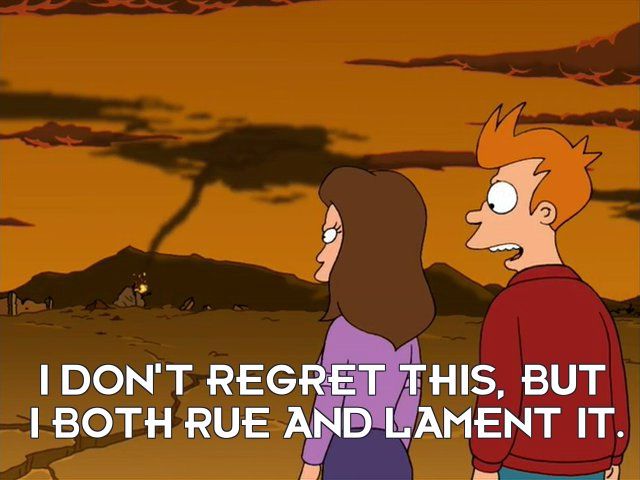The much-derided NFT market has taken yet another nosedive. Is the end of the suffering in sight?
It’s been almost two years since someone paid US$1.3 million (400 ETH at the time) for this picture of a rock.
Looking back now, it’s a true sign of the delirium we were in that we saw this event and went, “Yeah, you’re right, the bull market is just starting. See you at $1 million BTC.”
As markers of imminent fiscal catastrophe go, news stories of the type “Can you believe X paid Y for Z?” are as reliable as they come. (See also, “everyone is getting rich and you’re not”.) You see these stories pop up on your feed and the only responsible action is to calmly, quietly walk to your computer, sell everything you own and stuff the cash in a mattress in your basement.
Yet when it came to NFTs we were so confident. Rather than being the symbol of crypto’s coming downfall, NFTs were going to be the technology that saved us, a multifaceted model of digital ownership that was sure to drive the normies to our cause. It just made so much sense. I mean, Facebook had renamed itself Meta for the love of god. How could it possibly fail?

Kind of blue chip
I got into NFTs at the literal peak. It was January 2022 and while the rest of crypto prepared to fall face first into a vat of toxic goo, NFTs/web3/the metaverse appeared immune to the gravitational crunch consuming the rest of the space.
They, of course, weren’t, and when the end came the punishment was swifter and more savage for having defied correction for so long. Quickly we came to realise what the skeptics had been talking about when they called NFTs “crypto but with zero liquidity”. Where were the market makers for my crudely rendered picture of a creature with a dick coming out of its butt? I demand satisfaction!
Even so, there were certain blue chip collections that resisted the worst. PFP (profile pic) collections like the Bored Apes, Cryptopunks and Azukis appeared to have sufficiently established their totemic status that they were only lightly buffeted by the category 6 hurricane tearing apart the rest of the NFT scene. Think of it as one of those animes where the wealthy few live in a floating citadel, literally throwing their trash on those stuck on the surface.
Back to Elementals
Well, the citadel is suddenly looking real shaky. Two weeks back the Azuki team dropped a new round of NFTs, the Azuki Elementals, bringing in a shade over US$38 million for a collection of 20,000 images that, to many holders, looked basically identical to the original Azukis.
Suffice it to say that people were pissed. Azukis are down more than 50% and most of the blue chips have followed. Prices are lower than they’ve been in more than 2 years as holders get the hell out of Dodge. The NFT community right now is like some dude waking up from a hypnotist’s routine to discover that he’s been brushing his teeth with a hot dog. “I’ve been a fool! All these pictures are exactly the same!”
While NFT projects disappointing their followers is nothing new, the outsized reaction has a real “straw, meet camel’s back” vibe. NFTs needed a good news story and this was far from it. Indeed, if you wanted a symbol of the malaise afflicting the whole industry then it’s definitely an insanely well-funded company being unable to muster the effort or inspiration to actually create something of value or interest for their loyal users, despite having all the time and resources in the world to do so.
More like fart on the blockchain
My take: generative PFPs, the original and still primary use case of an NFT, are reaching the end of their usefulness. They served their purpose as an introduction to the function and scarcity mechanics of an NFT, but PFPs are neutered by design, basically unable to expand membership or culture without wronging the community that made them worth something in the first place.
But on the flipside, crypto is nothing if not an exercise in creative destruction. In the aftermath of the 2013 bubble, when the market was saturated with Bitcoin clones, knock-offs and novelty coins, it took an almighty cleansing before the mania of 2017 could take hold.
Right now the vast majority of the NFT space is made up of PFP clones, knock-offs and novelty mints. When they vaporise, will it clear the air for NFT technology to fulfil its promise? And what will become the Ethereum of the NFT market? If crypto has taught us anything it’s that you can’t have resurgence without capitulation. Hopefully this is the beginning of the end, so the rebuilding can commence.
And as for that picture of a rock, the best offer on OpenSea right now is US$18,700, or 10 ETH, a 98.5% drawdown. Fool’s gold or the opportunity of a lifetime?
Luke from CoinJar
CoinJar’s digital currency exchange services are operated in Australia by CoinJar Australia Pty Ltd ACN 648 570 807, a registered digital currency exchange provider with AUSTRAC; and in the United Kingdom by CoinJar UK Limited (company number 8905988), registered by the Financial Conduct Authority as a Cryptoasset Exchange Provider and Custodian Wallet Provider in the United Kingdom under the Money Laundering, Terrorist Financing and Transfer of Funds (Information on the Payer) Regulations 2017, as amended (Firm Reference No. 928767). Cryptoassets carry high risk. Due to the potential volatility of the cryptoasset markets, the value of your investments may fall significantly and lead to total loss. Cryptoassets are complex and are unregulated in the UK, and you are unable to access the UK Financial Service Compensation Scheme or the UK Financial Ombudsman Service. We use third party banking, safekeeping and payment providers, and the failure of any of these providers could also lead to a loss of your assets. We recommend you obtain financial advice before making a decision to use your credit card to purchase cryptoassets or to invest in cryptoassets. Capital Gains Tax may be payable on profits.
- SEO Powered Content & PR Distribution. Get Amplified Today.
- PlatoData.Network Vertical Generative Ai. Empower Yourself. Access Here.
- PlatoAiStream. Web3 Intelligence. Knowledge Amplified. Access Here.
- PlatoESG. Automotive / EVs, Carbon, CleanTech, Energy, Environment, Solar, Waste Management. Access Here.
- BlockOffsets. Modernizing Environmental Offset Ownership. Access Here.
- Source: https://blog.coinjar.com/nfts-all-the-way-down/
- :has
- :is
- :not
- :where
- $1 million
- $UP
- 000
- 10
- 20
- 2013
- 2017
- 2022
- 700
- 98
- a
- About
- access
- ACN
- Action
- actually
- advice
- aftermath
- AIR
- All
- also
- an
- and
- Another
- any
- anything
- apart
- Apes
- appeared
- ARE
- AS
- Assets
- At
- Australia
- authority
- Azuki
- back
- Banking
- Basically
- BE
- become
- been
- before
- Beginning
- being
- believe
- BEST
- Bitcoin
- Blue
- Bored
- Bored Apes
- Bringing
- BTC
- bubble
- bull
- Bull Market
- but
- by
- called
- came
- CAN
- capital
- capital gains
- capital gains tax
- capitulation
- card
- carry
- case
- Cash
- Category
- Cause
- certain
- chip
- Chips
- Citadel
- clear
- CNET
- CoinJar
- Coins
- collection
- collections
- COM
- come
- coming
- community
- company
- Compensation
- complex
- computer
- Conduct
- could
- Course
- create
- Creative
- creature
- credit
- credit card
- crunch
- crypto
- cryptoasset
- cryptoassets
- CryptoPunks
- Culture
- Currency
- custodian
- decision
- defied
- definitely
- Demand
- Design
- Despite
- digital
- digital currency
- digital currency exchange
- digital ownership
- disappointing
- discover
- do
- Dog
- down
- downfall
- drive
- dropped
- due
- effort
- end
- established
- ETH
- ethereum
- Event
- everything
- exactly
- exchange
- Exercise
- Expand
- Face
- FAIL
- Failure
- Fall
- far
- few
- financial
- financial advice
- Financial Conduct
- Financial Conduct Authority
- financial service
- financing
- Firm
- First
- Fiscal
- flipside
- floating
- followed
- followers
- For
- from
- function
- funds
- Gains
- generative
- get
- getting
- Go
- God
- going
- Gold
- GOO
- good
- gravitational
- had
- Have
- having
- his
- hold
- holders
- Hopefully
- HOT
- How
- HTML
- HTTPS
- hurricane
- i
- identical
- if
- images
- imminent
- in
- indeed
- industry
- information
- Inspiration
- interest
- into
- Introduction
- Invest
- Investments
- IT
- ITS
- itself
- January
- jpg
- just
- Kingdom
- Laundering
- lead
- lifetime
- lightly
- like
- Limited
- live
- Long
- looked
- looking
- loss
- love
- lower
- loyal
- Ltd
- made
- Majority
- Makers
- Making
- many
- Market
- market makers
- Markets
- May..
- mean
- mechanics
- Meet
- membership
- Meta
- Metaverse
- million
- model
- money
- Money Laundering
- more
- most
- much
- multifaceted
- my
- needed
- New
- news
- NFT
- NFT community
- nft market
- NFT projects
- NFT space
- NFT technology
- NFTs
- no
- nothing
- novelty
- now
- number
- obtain
- of
- offer
- on
- ONE
- only
- operated
- Opportunity
- or
- original
- our
- out
- over
- own
- ownership
- paid
- party
- payment
- payment providers
- People
- PFP
- picture
- Pictures
- Place
- plato
- Plato Data Intelligence
- PlatoData
- pop
- possibly
- potential
- prepared
- Prices
- primary
- Profile
- profits
- projects
- promise
- provider
- providers
- purchase
- purpose
- quickly
- quietly
- rather
- reaching
- reaction
- real
- rebuilding
- recommend
- registered
- regulations
- reliable
- Resources
- responsible
- REST
- Rich
- right
- Rock
- round
- saw
- say
- Scarcity
- scene
- scheme
- see
- sell
- sense
- service
- Services
- Sight
- sign
- significantly
- since
- Skeptics
- So
- some
- Someone
- something
- Space
- Starting
- Status
- Still
- Stories
- Story
- suffering
- sure
- Surface
- symbol
- Take
- taken
- talking
- taught
- tax
- team
- Technology
- terrorist
- terrorist financing
- than
- that
- The
- the UK
- the United Kingdom
- the world
- their
- Them
- then
- There.
- These
- they
- think
- Third
- this
- those
- Throwing
- time
- to
- took
- Total
- transfer
- true
- two
- type
- Uk
- unable
- under
- United
- United Kingdom
- us
- use
- use case
- users
- value
- Vast
- VAT
- Vibe
- Volatility
- Wallet
- wanted
- was
- Way..
- we
- Weeks
- went
- were
- What
- when
- while
- whole
- will
- with
- without
- world
- Worst
- worth
- X
- years
- yet
- You
- Your
- zephyrnet
- zero













